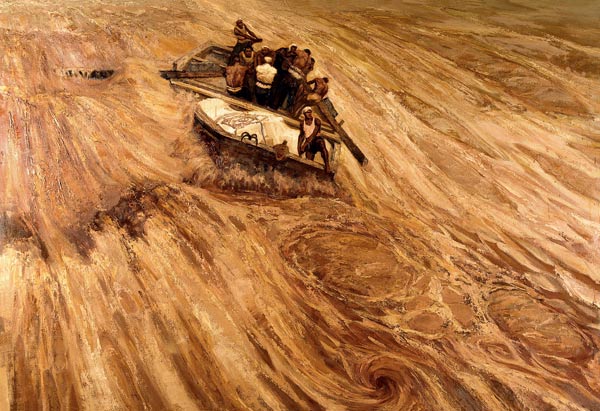

The oil-on-canvas work Breaking the Waves in Currents was created by Du Jian in 1963.
The work of China's contemporary art masters may be familiar, but art patrons can see its genesis in a new exhibition of their earliest works. Lin Qi takes a look at what these painters were doing in art school.
People may have seen the works of noted Chinese contemporary artists at galleries, art fairs and auctions that cost hundreds of thousands of yuan, sometimes even millions. Now an exhibition at the nation's top art museum shows some of these celebrated artist' earliest works created when they were only teenagers.
The exhibition to mark the 60th birthday of the Central Academy of Fine Arts' affiliated high school offers a glimpse into the start of pioneering artists, such as Xiao Lu, Liu Xiaodong, Xia Junnan and Qiu Xiaofei. Their early drawings display their immature handling of brushes, but give a hint of how these artists would develop their distinguished styles.
The Fine Arts School Affiliated with the CAFA was founded as New China's first professional art school. It cultivated the republic's first generation of art educators and painters.
"The exhibition looks back on not only the regularization of China's art education after 1949. It also reflects upon and salutes the construction of New China," the school's headmaster Ma Gang says.
Some of the exhibits come from the collection of the National Art Museum of China, where the exhibition is held. Most of them are the so-called "history-themed artworks" that are large in size and depict landmark political events and iconic scenes of the nation's social development.
At the Front of Tian'anmen Gate, for example, was painted in 1964 by Sun Zixi when he taught at the school; he later retired as a professor with the CAFA. Sun took the perspective of a photographer to portray three groups of visitors at Tian'anmen Square. He didn't stress the contrast of dark and bright in this oil painting. Instead he drew inspiration from traditional Chinese New Year paintings, or nianhua, to present people's happiness and love for the new republic at that time. The painting is printed on NAMOC's tickets.
The school has been a launchpad for the careers of many of its teachers and students, long before their rise to stardom.
Ai Xuan, a representative of China's realistic painting, graduated from the school in 1967. He spent several years in the Tibetan areas in Sichuan province, during which he was deeply impressed by Tibetan people and their customs. His signature work on show, Norgay, exemplified a turning point in his work after 1982: He stopped sketching landscapes to seek a new form of expression and composition. In this oil painting of 1985, he applied the sentimental and realistic style of Andrew Wyeth to profile a lonely Tibetan man against a snowy white background.
The realistic approach continues to be the center of curriculum for those who attend or teach at Ai's alma mater, says Ma the headmaster.
Located in the Yanjiao Economic and Technological Development Zone, some 30 kilometers from Beijing's city center, the boarding school will hold its annual entrance exams in early May. It plans to enroll 200 students, while there are about 1,200 hopefuls coming from across the country to take the test, says Lu Peng, a visitor to the exhibition who runs a private coaching classroom for these applicants near the school.
Lu's 20-odd students prepare for text exams in other training classes in the morning, and brush up with their basic painting skills in Lu's class for nine to 10 hours a day.
"The school is where these gifted students can sharpen their eyes to appreciate art. They frequently tour the 798 art district and the many museums downtown; they talk about what Damien Hirst has been doing. They have access to better education resources that will guarantee them advantages on the entrance exams for the art colleges," he says.
If you go:
9 am-5 pm, until April 8. National Art Museum of China, 1 Wusi Dajie (Avenue), Dongcheng district, Beijing. 010-6400-1476.
Ink portraits on display in Beijing
2014-03-27Calligraphic art of Chairman Mao on display
2014-03-14Copyright ©1999-2018
Chinanews.com. All rights reserved.
Reproduction in whole or in part without permission is prohibited.